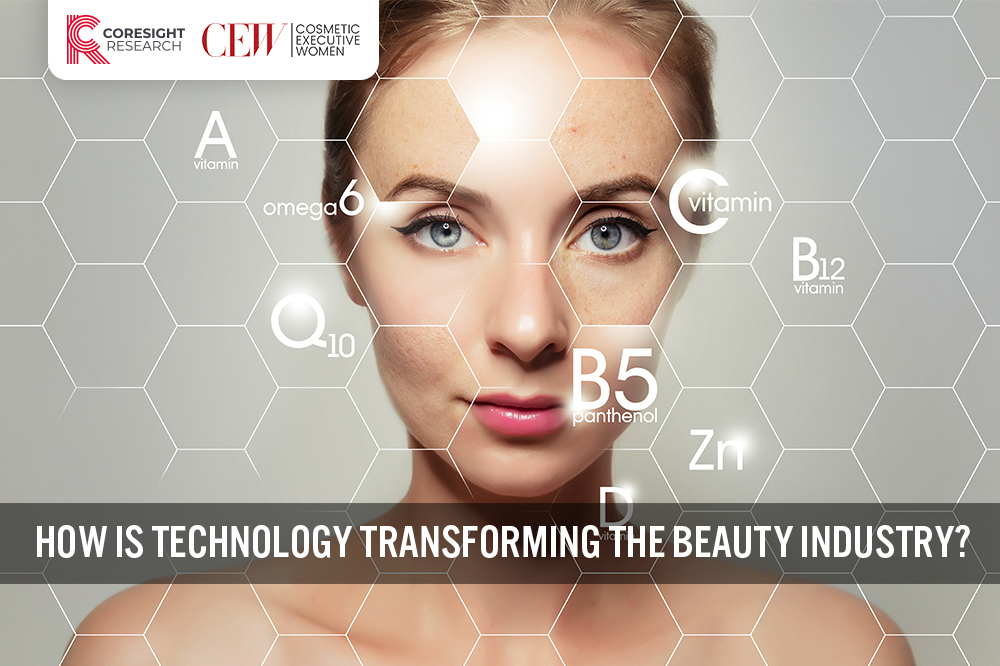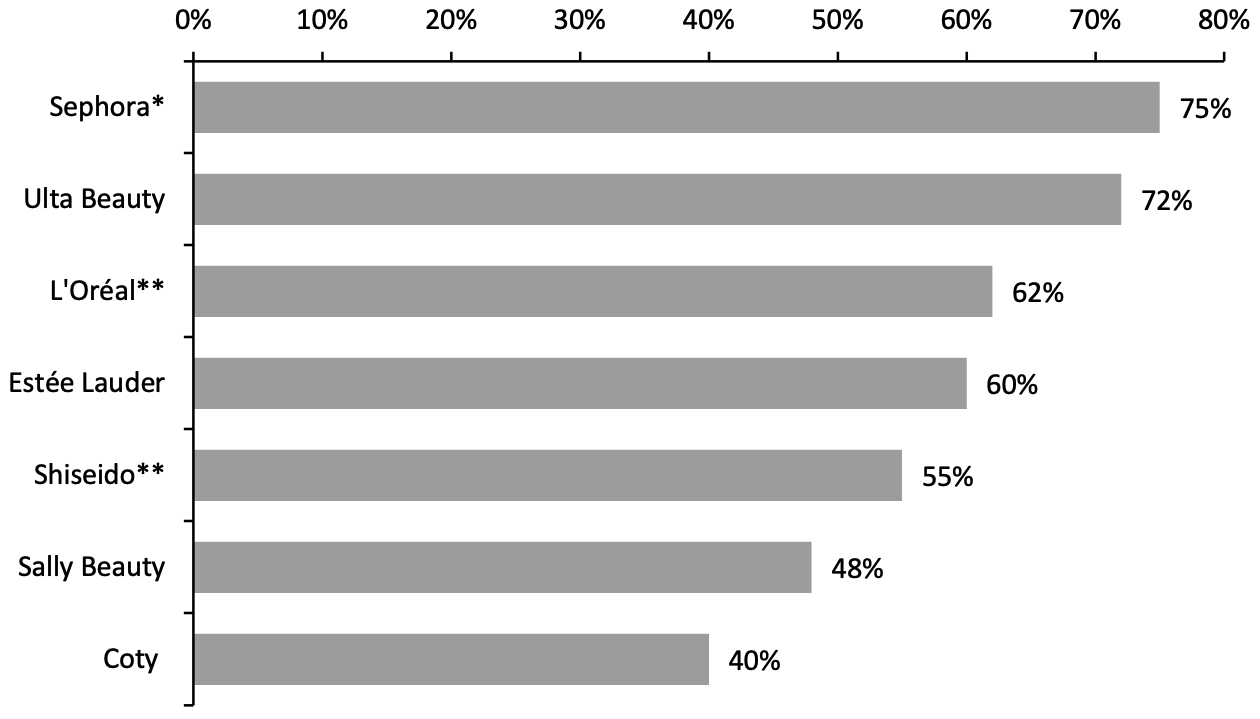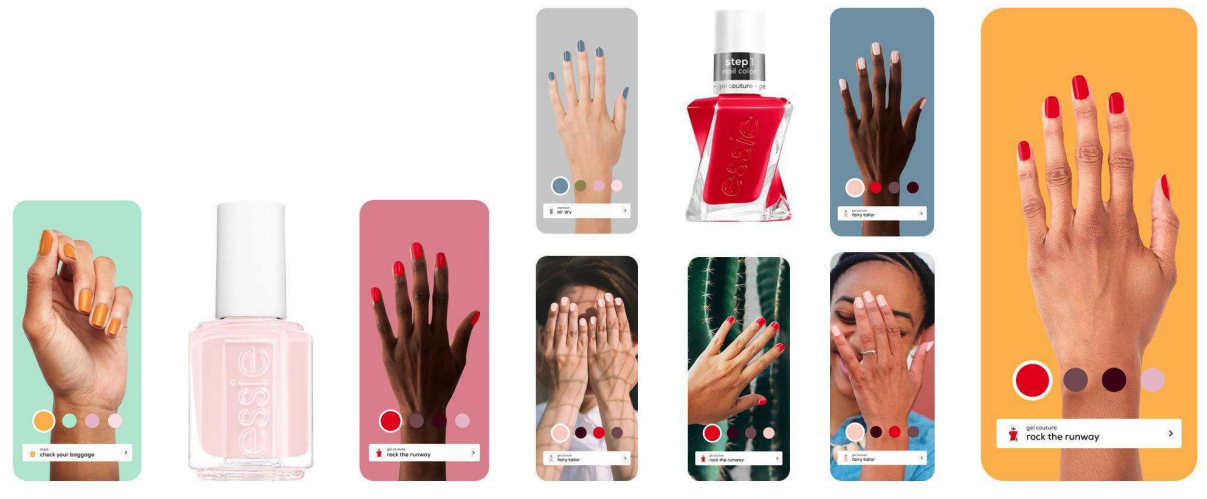
albert Chan
What’s the Story?
Today’s beauty consumers look for a high level of online interaction with brands and retailers. Given the negative impact of the Covid-19 pandemic, which has given rise to concerns around hygiene, we are seeing more beauty brands embrace new technologies such as AI, AR and VR to engage with consumers online and offer them a more personalized beauty shopping experience. In this report, we explore how technology is transforming the beauty industry and highlight the implications of its adoption for brands and retailers.Why It Matters
Pandemic-led store closures, social-distancing measures and self-quarantines have prompted consumers to turn to the digital channel for beauty shopping, resulting in an unprecedented surge in e-commerce demand. We have seen many beauty brands and retailers report robust growth in online sales in their latest quarter or full fiscal year, as shown in Figure 1. These brands and retailers have also noted that online business remains strong despite store reopenings in the second half of 2020. Figure 1. Online Sales Growth at Selected Beauty Brands and Retailers in Their Latest Reporting Periods (YoY % Change) [caption id="attachment_124821" align="aligncenter" width="720"] For Sephora, the quarter ended December 31, 2020; for Ulta Beauty, the quarter ended January 31, 2021; for L’Oréal, the fiscal year ended December 31, 2020; for Estée Lauder, the quarter ended December 31, 2020; for Shiseido, the fiscal year ended December 31, 2020; for Sally Beauty, the quarter ended December 31, 2020; for Coty, the quarter ended December 31, 2020
For Sephora, the quarter ended December 31, 2020; for Ulta Beauty, the quarter ended January 31, 2021; for L’Oréal, the fiscal year ended December 31, 2020; for Estée Lauder, the quarter ended December 31, 2020; for Shiseido, the fiscal year ended December 31, 2020; for Sally Beauty, the quarter ended December 31, 2020; for Coty, the quarter ended December 31, 2020*Coresight Research estimate of Sephora USA’s online sales growth
**Online sales growth for fiscal 2020
Source: Company reports/Coresight Research[/caption]
Technology in the Beauty Industry: In Detail
The acceleration of e-commerce has caused beauty brands and retailers to rethink their strategies to better engage with consumers digitally, enabled by technology innovators. We discuss three technology areas that are supporting brands’ strategies moving forward: virtual product testing, AI and personalization, and virtual stores and events. Virtual Product Testing: Increase Consumer Engagement and Conversion Rate Although virtual try-on technology is not exactly new, its adoption has been accelerated due to the pandemic. Due to increased consumer awareness of hygiene issues related to physically trying on products, virtual try-on is becoming a must-have service in the beauty market—and the results so far have been promising. Beauty conglomerate L’Oréal was one of the early adopters of virtual try-on technology. As part of its efforts to “reinvent the beauty experience,” according to the company, L’Oréal acquired AR company ModiFace in 2018 to expand into virtual makeup and hair-color try-on services. ModiFace’s 3D facial recognition software enables try-on simulations of beauty products on photos or videos. L’Oréal has utilized ModiFace to launch virtual try-on functionality across most of its brands. Lubomira Rochet, Chief Digital Officer at L’Oréal, noted that during the pandemic, the company saw virtual try-on usage increase fivefold, reaching 1 billion user visits. Conversion rates from virtual try-on tripled.- On February 19, 2021, nail brand Essie unveiled a virtual try-on salon that allows users to discover and try Essie nail polishes using AR. Leveraging camera technology, the web-based tool virtually applies nail polish to the user’s nails by tracking nail shape and movement of fingers. According to Essie, users can try 75 gel couture shades with the tool.
 Essie’s virtual try-on salon
Essie’s virtual try-on salonSource: Essie[/caption]
- Google partnered with ModiFace and beauty tech company Perfect Corp in December 2020 to launch its new AR beauty tool, which allows users to access virtual try-on for selected beauty products on Google Search. The collaboration extends to Google’s video-sharing platform, YouTube.
- In November 2020, L’Oréal introduced AR filters to multiple social media and video-calling apps, including Google Duo, Google Hangouts, Instagram, Microsoft Teams, Snapchat, Zoom and more. ModiFace has also previously worked with Facebook.
 YSL Rouge Sur Mesure, Powered by Perso
YSL Rouge Sur Mesure, Powered by PersoSource: L’Oréal[/caption] Over the years, L’Oréal has developed different personalized beauty technologies, including SkinCeuticals’ customized D.O.S.E serum, Lancôme’s foundation machine that is used to help consumers to find the perfect foundation shade to match their skin tone, and La Roche-Posay’s sensor clips that measure the skin’s exposure to UV and pollution. AI has also been widely used to provide skin diagnostics and skincare recommendations. In September 2020, Perfect Corp released its upgraded AI skin-diagnostic solution to include more tracking metrics, including moisture, oiliness, redness, acne, spots, wrinkles, texture, dark circles and more. The technology instantly analyzes eight skin-health metrics for consumers and allows skincare brands to offer personalized product recommendations that meet their specific skin concerns. The solution generates an overall skin score for customers to use as a baseline in tracking their skin health and monitor improvements over time. Announced on March 2, 2021, Japanese beauty brand Decorté became one of the first brands to adopt Perfect Corp’s technology in the US on its e-commerce site. Direct-to-consumer (DTC) beauty brands are often pioneers in customized beauty. Two notable examples are as follows:
- Function of Beauty enables consumers to take a quick quiz on its website to determine a personalized formula for hair products. The company reported strong month-over-month growth between January and April 2020 despite reduced advertising spending. Function of Beauty also unveiled its customizable skincare line in October 2020.
- Customized serum brand Atolla saw a significant increase in customers who had rarely shopped online for skin care before, notably Gen Z and Baby Boomers, between mid-March and April 2020, according to the company.
 Source: Charlotte Tilbury[/caption]
US clean-beauty brand bareMinerals hosted a shoppable Virtual Villa event on its e-commerce site on March 2, 2021. The seaside villa consisted of virtual storefronts and multiple rooms featuring various video content from a range of beauty experts. The tour through the villa was guided by videos of celebrity Hailey Bieber, a bareMinerals clean-beauty ambassador. Users could watch video content, participate in interactive activities and purchase products in the virtual storefront, which linked to the brand’s website.
Fenty Skin, skincare brand of celebrity Rihanna, used VR and livestreaming to host its launch party in July 2020. Attendees of the virtual party could click to enter different rooms, including a “bar”, a “spa” that showcased products, and a “living room” that featured livestreams from Rihanna and other celebrities.
Implications
Virtual events and storefronts are still in their infancy and may lose some relevancy when the pandemic eases. However, post pandemic, we see reality technology as providing an opportunity for brands to further connect with consumers, complementing their existing marketing strategies.
VR recreates aspects of physical retail through the incorporation of music, store displays and product merchandising to offer a memorable, immersive shopping experience. With innovation in technology continuing to step up, brands can more closely mimic the in-store experience. Another benefit of virtual storefronts or events over in-person experiences is the ability they provide brands to reach a wider audience, as anyone who has access to the Internet can join.
Online storefronts or events can face challenges in keeping attendees engaged. Beauty brands should focus more on the experience side than the hard sell. For example, brands can invite influencers and celebrities to interact with viewers, or they can add gaming functions as a fun and entertaining element. The integration of games can help brands build the perception that they are innovative and edgy to appeal to younger demographics. High-end beauty brand Tatcha ventured into popular Nintendo game Animal Crossing back in August 2020 with its own virtual island, “Tatchaland,” to celebrate the launch of its new cleanser. Gamers who visit Tatchaland can interact with the avatar version of Tatcha’s founder and learn more about the products.
Source: Charlotte Tilbury[/caption]
US clean-beauty brand bareMinerals hosted a shoppable Virtual Villa event on its e-commerce site on March 2, 2021. The seaside villa consisted of virtual storefronts and multiple rooms featuring various video content from a range of beauty experts. The tour through the villa was guided by videos of celebrity Hailey Bieber, a bareMinerals clean-beauty ambassador. Users could watch video content, participate in interactive activities and purchase products in the virtual storefront, which linked to the brand’s website.
Fenty Skin, skincare brand of celebrity Rihanna, used VR and livestreaming to host its launch party in July 2020. Attendees of the virtual party could click to enter different rooms, including a “bar”, a “spa” that showcased products, and a “living room” that featured livestreams from Rihanna and other celebrities.
Implications
Virtual events and storefronts are still in their infancy and may lose some relevancy when the pandemic eases. However, post pandemic, we see reality technology as providing an opportunity for brands to further connect with consumers, complementing their existing marketing strategies.
VR recreates aspects of physical retail through the incorporation of music, store displays and product merchandising to offer a memorable, immersive shopping experience. With innovation in technology continuing to step up, brands can more closely mimic the in-store experience. Another benefit of virtual storefronts or events over in-person experiences is the ability they provide brands to reach a wider audience, as anyone who has access to the Internet can join.
Online storefronts or events can face challenges in keeping attendees engaged. Beauty brands should focus more on the experience side than the hard sell. For example, brands can invite influencers and celebrities to interact with viewers, or they can add gaming functions as a fun and entertaining element. The integration of games can help brands build the perception that they are innovative and edgy to appeal to younger demographics. High-end beauty brand Tatcha ventured into popular Nintendo game Animal Crossing back in August 2020 with its own virtual island, “Tatchaland,” to celebrate the launch of its new cleanser. Gamers who visit Tatchaland can interact with the avatar version of Tatcha’s founder and learn more about the products.
What We Think
The Covid-19 pandemic has accelerated digital innovation in the beauty industry, as consumers are embracing online shopping more than ever before. In recent earnings calls hosted by beauty conglomerates Estée Lauder and L’Oréal, both companies identified digitalization in beauty as a key trend going forward and expressed confidence in ongoing e-commerce momentum. Technologies such as AR and VR were once considered niche but have been gaining great traction recently. A growing list of beauty brands are investing in AI, AR and VR to elevate the online shopping experience for consumers. Implications for Brands/Retailers- Beauty technologies are becoming a “must have” in brands’ e-commerce strategies, as they drive traffic, increase consumer engagement and boost conversion.
- We see virtual product testing as a trend that will stick post pandemic, online but also in stores, due to increased consumer awareness around hygiene; they are reluctant to touch or try on products that others have already touched.
- Instead of in-house innovation, brands and retailers can partner with existing or emerging beauty tech startups to speed up AR deployment at lower costs. They could also consider moving the virtual try-on experience from their own apps to mainstream social media platforms or e-commerce platforms to increase product exposure to a broader audience.
- Consumers are becoming accustomed to increasing levels of product personalization, and the one-size-fits-all approach does not work in the beauty space. Personalized beauty is therefore likely to be a key differentiating factor for brands to increase consumer loyalty.
- We view virtual stores or events as a complementary marketing approach to store-based retail. We expect that the future shopping journey will continue to be omnichannel, so brands should look to provide immersive shopping experiences both online and offline.